International Follow-up Committee
The 24th of January 2019, an international follow-up committee gathered together in Brussels to discuss the progress of the ArtGarden project. International experts such as Bart Ankersmit, Stefan Michalski, José Luiz Perdesoli Junior and Ruven Pillay took part. Together with Belgian experts and the project members, subjects such as the definition of historical mixed-media ensembles, problematic material combinations, case studies and the decision support tool were discussed.

Late Medieval Paradise Gardens Revealed
Totally fascinated by the Enclosed Gardens? Certainly read the newly published book “Enclosed Gardens of Mechelen. Late Medieval Paradise Gardens Revealed”.
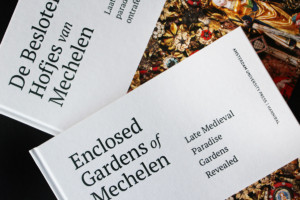
This book was published on the occasion of the completion of the Enclosed Gardens project of the Museum Hof van Busleyden, Mechelen and KULeuven, Illuminare – Centre for the Study of Medieval Art (2014-2018). The essays in this publication were presented during the conference Imaging Utopia: New Perspectives on Northern Renaissance Art. XXth Symposium for the Study of Underdrawing and Technology in Painting (Illuminare – Centre for the Study of Medieval Art, 11 January 2017, Mechelen).
Back to the core: Unveiling the pigments of the panel paintings
Caroline Meert (KIK-IRPA) and Marina Van Bos (KIK-IRPA)
In March, the painted wings of the Enclosed Garden with Daniel in the Lion’s Den travelled to Brussels. Within the conservation-laboratories of the KIK-IRPA they were seen under a whole new light through MA-XRF or XRF-mapping. Under the care and well-trained eye of Marina Van Bos, conservation scientist in the KIK-IRPA, they revealed themselves. This information is very valuable, not only from a conservation point of view (some pigments are for example more sensible to light than others), but also to complete the art-historical information…
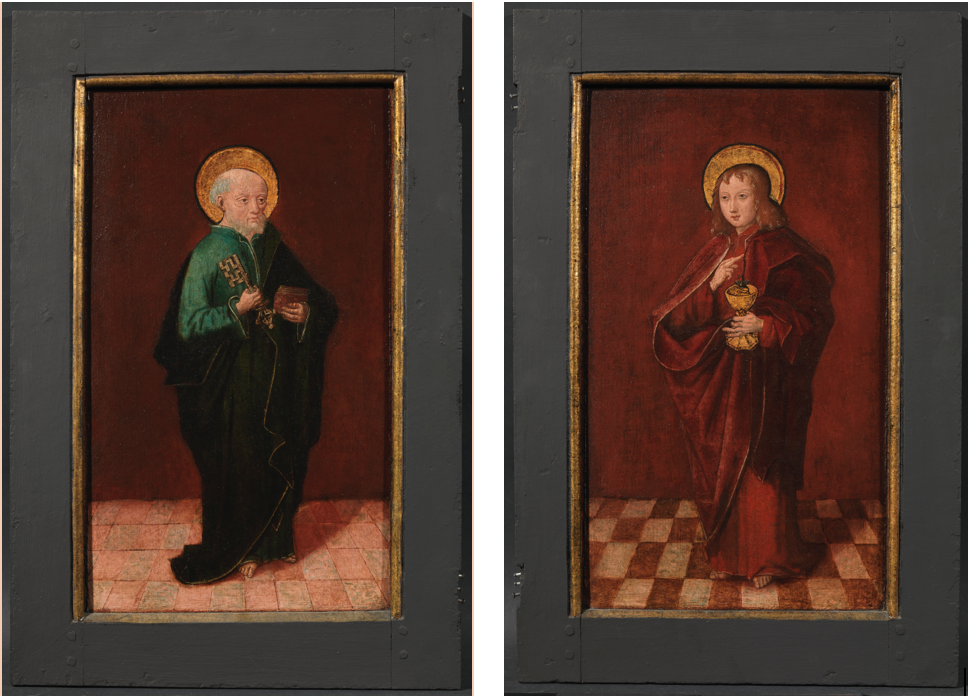 Painted wings representing Saint Peter and Saint John the Evangelist
Painted wings representing Saint Peter and Saint John the Evangelist
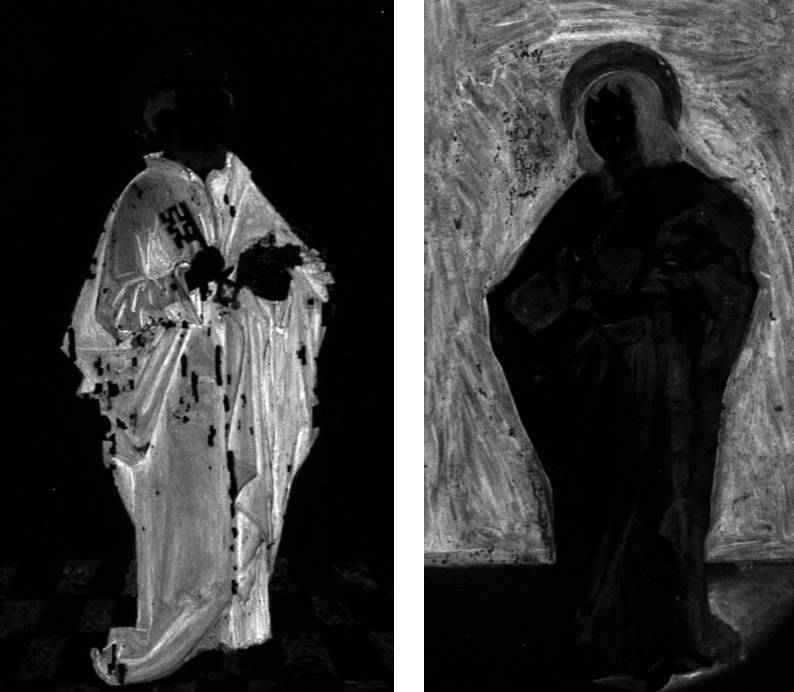 XRF-mapping result (Left: Cu, Right: Fe)
XRF-mapping result (Left: Cu, Right: Fe)
With this technique, the painting surface is irradiated with a very narrow X-ray beam and the characteristic X-ray fluorescence is detected and allows to identify the chemical elements present in the analysed area. The scanning results in detailed images showing the elementary components in the paint layers such as copper, lead, iron, calcium, mercury,… Based on this, it could be concluded that pigments like lead white, copper green, vermillion, red ochre,… were applied in the atelier of the master during the creation of the painting. This brings us one step closer to complete the material biography of this fascinating piece of history. We are already looking forward to the next piece of the puzzle in completing the objects story.
Keywords: Technical Art History, XRF-mapping, MA XRF, Painted wings, Enclosed Gardens
______________
Enclosed Garden with Daniel in the Lion’s Den
Hannah Iterbeke (PhD Candidate, KU Leuven)
In January, the conservation team has removed the nineteenth-century glass plate from the Enclosed Garden which holds the statues of Daniel in the lions’ den. A small introduction on this Enclosed Garden and its iconography seems thus in order!
 This sixteenth-century Enclosed Garden with Daniel in the lions’ den belonged to the Gasthuiszusters of Mechelen. It depicts the old testament scene of the prophet Daniel who, after remaining faithful to his forbidden Christian faith, was thrown in a sealed lions’ den by the king Darius. Carried by an Angel, the minor prophet Habakkuk was able to provide Daniel with food without breaking the seal of the den. After several days, the lions’ den was opened and the king found Daniel alive. Daniel proclaimed that he survived this torture with the help of the lord. The polychrome wooden sculptures in the middle of the Enclosed Garden depicts a preaching Daniel in the den surrounded by four lions. At his left, the prophet Habakkuk is carried by an angel; in his hands he carries a small basket with food.
This sixteenth-century Enclosed Garden with Daniel in the lions’ den belonged to the Gasthuiszusters of Mechelen. It depicts the old testament scene of the prophet Daniel who, after remaining faithful to his forbidden Christian faith, was thrown in a sealed lions’ den by the king Darius. Carried by an Angel, the minor prophet Habakkuk was able to provide Daniel with food without breaking the seal of the den. After several days, the lions’ den was opened and the king found Daniel alive. Daniel proclaimed that he survived this torture with the help of the lord. The polychrome wooden sculptures in the middle of the Enclosed Garden depicts a preaching Daniel in the den surrounded by four lions. At his left, the prophet Habakkuk is carried by an angel; in his hands he carries a small basket with food.
This old testament scene can be interpreted as a prefiguration of the Virgin Mary. Just as the unbroken seal of the lions’ den, Mary remained a virgin after her pregnancy with the Christ Child.
The sculpture of Daniel in de lions’ den is surrounded by two other figures, the Virgin and Child with Saint Anne, and Saint Jerome. These figures are, in contrast to most sculptures adorning the Enclosed Gardens, not made in wood but in alabaster.
In contrast to its name, this Enclosed Garden is not enclosed by gate. It is possible that this gate was removed over time, which might explain the small red velvet strip at the bottom, which could have served as a support, but it is also possible that there never was a such a gate.
In the background of this garden we can distinguish two pipe clay medallions. On the left medallion, a profile of Christ is depicted. Even though the provenance of this piece is uncertain, it is clear that this medallion was in no way unique. It seems it was derived from an Italian, probably Florentine, bronze medallion. This Florentine model was the foundation for many derivatives; from a papier-mâché relief found in Wienhausen to a church bell cast in Mechelen. The same can be said about the right medallion. This image has also been depicted on church bells and several individual examples are still in private collections.
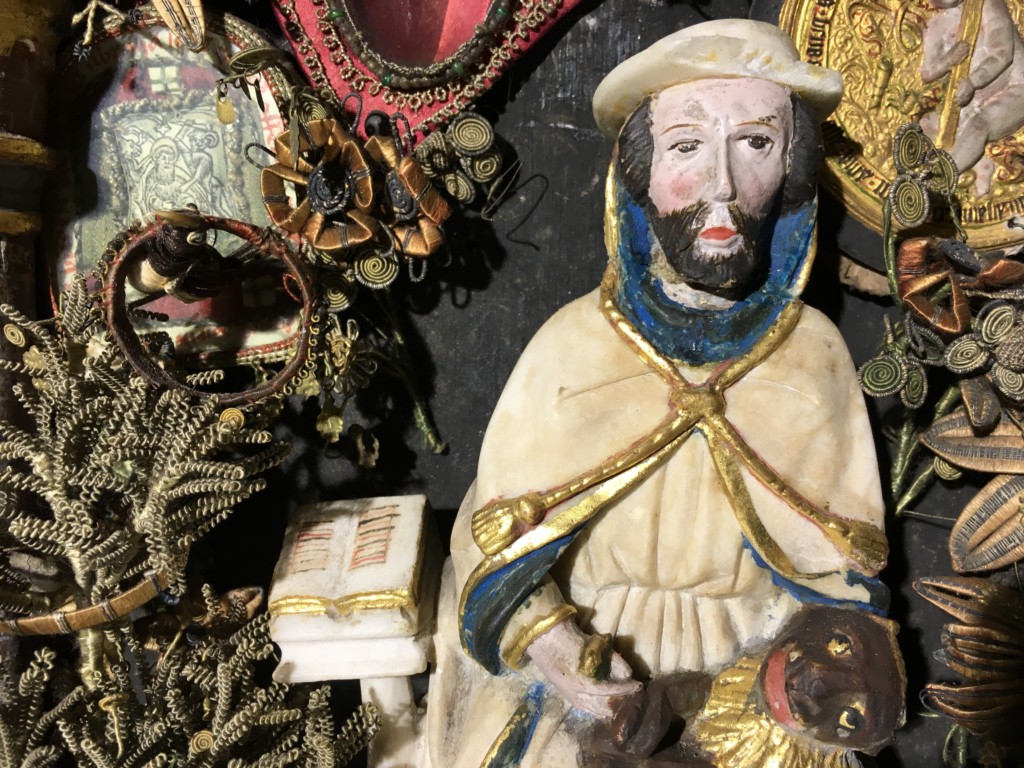 Besides these two pipe clay medallions, another type of medallion is attached to the background of this Enclosed Garden. On the right of the Daniel sculpture, a small print depicting the Temptation of Saint Anthony can be seen. This print is framed by intertwined silver threat and subsequently fixed on a piece of cotton and red velvet on which three small relics seem to be attached. The composition is surrounded by a banderol on which an inscription in old Dutch can be distinguished. These inscriptions functioned as authenitica, confirming the provenance of the relics and the connection to their past. Although only parts of the inscription can be read, it seems to state the following: ‘This is from the tree where Abraham offered his son…’. It is therefore probable that these packages hold dirt, stones or wood functioning as a kind of ‘earth relics’. The whole composition is placed within a wooden or cardboard frame covered by a thin glass plate.
Besides these two pipe clay medallions, another type of medallion is attached to the background of this Enclosed Garden. On the right of the Daniel sculpture, a small print depicting the Temptation of Saint Anthony can be seen. This print is framed by intertwined silver threat and subsequently fixed on a piece of cotton and red velvet on which three small relics seem to be attached. The composition is surrounded by a banderol on which an inscription in old Dutch can be distinguished. These inscriptions functioned as authenitica, confirming the provenance of the relics and the connection to their past. Although only parts of the inscription can be read, it seems to state the following: ‘This is from the tree where Abraham offered his son…’. It is therefore probable that these packages hold dirt, stones or wood functioning as a kind of ‘earth relics’. The whole composition is placed within a wooden or cardboard frame covered by a thin glass plate.
Other than these medallions and sculptures, this Enclosed Garden is filled with wax seals (Agnus Dei), silk flowers and animals, inscriptions, textiles, small drawings in metal frames, rolls of paper and small sequins.
The garden can be closed with two painted wings on which Saint Peter (left) and Saint John the Evangelist are depicted.
Keywords: Art history, iconography, Enclosed Garden
______________
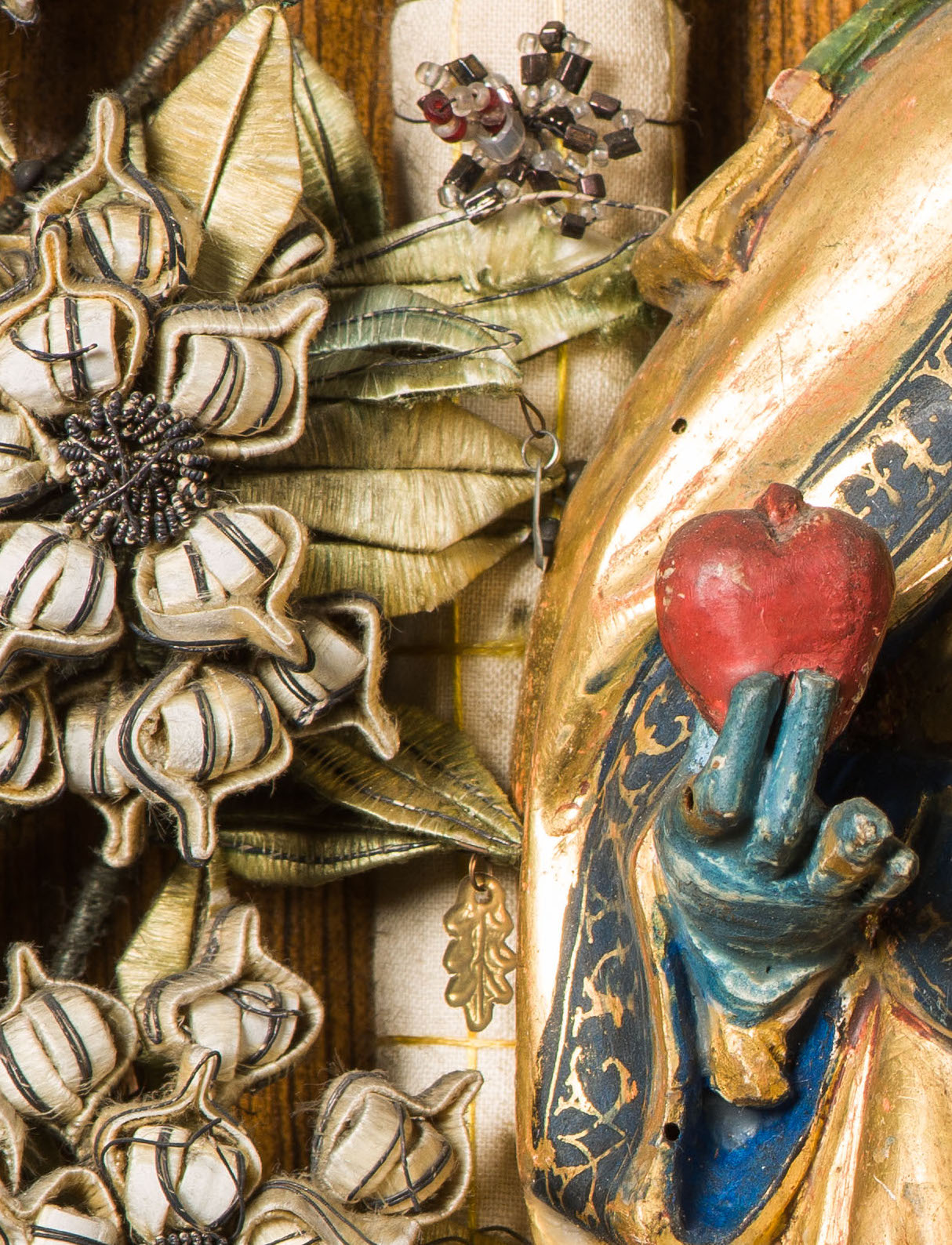
Welcome!
Welcome to the ArtGarden website. Stay informed on the project and its research results. We will be sharing the development of this research in several blogposts and pictures.

